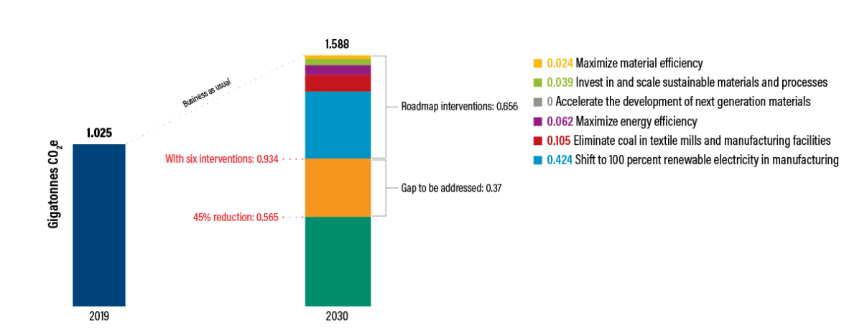
The 2023 edition of the “Taking Stock of Progress Against the Roadmap to Net Zero” report has updated the apparel sector’s greenhouse gas (GHG) estimate and compiled a range of examples (company and industry) that illustrate how the sector is taking concrete actions to reduce emissions.
Aii utilised Worldly data for its analysis, and fibre volume data from Textile Exchange to make such calculations.
Report highlights
- Based on data from the Sustainable Apparel Coalition, Worldly, and Textile Exchange, Aii estimates apparel sector emissions to be 0.897 gigatonnes (Gt) of carbon dioxide equivalent (CO2 e) in 2021, or roughly 1.8% of annual global greenhouse gas (GHG) emissions.
- Adjusting for changes in key assumptions on fibre allocation, this represents an increase of 0.87% from the 2019 estimate presented in the Roadmap to Net Zero.
- Assuming business-as-usual growth for the apparel sector, emissions are projected to be 1.266 Gt in 2030. To stay within a 1.5°C trajectory (45% reduction by 2030), the sector would need to reduce emissions from 0.889 Gt in 2019 to 0.489 Gt by 2030.
- The breakdown of emissions across the value chain for 2021 is nearly identical to that in the Roadmap to Net Zero: material processing (tier 2), is highest at 53% of total emissions, followed by raw materials (tier 4) at 23%, raw materials processing (15%), and finished goods assembly (8%).
- A selection of case studies of companies taking action to reduce GHG emissions across the six interventions identified in the Roadmap to Net Zero.
Call to action and next steps
By identifying six interventions in materials and production, the report offers a map to prioritise decarbonisation efforts within the industry. These six interventions deliver more than 60% of the necessary reductions to align with the 1.5-degree Celsius scenario:
- Look for opportunities to maximise material efficiency, in the process reducing waste of all kinds, including carbon.
- Increase the use of sustainable materials and practices — Textile Exchange has deep expertise and a variety of resources and tools to support companies in this transition.
- Explore and invest in the development of innovative materials — such materials are becoming more readily available.
- Maximize energy efficiency — particularly in the supply chain. Programs such as Aii’s mill efficiency program are proven to reduce energy and emissions and are readily deployed.
- Eliminate coal in manufacturing — this will be a big challenge, but the growing number of companies committing to coal phase-out will help stimulate lower carbon alternatives.
- Shift to 100 percent renewable electricity — in your own operations, and engage your suppliers to make the shift as well.
A seventh intervention, to advance the circular economy, undergirds both materials and production.

In 2021, WRI and Aii’s collective report, “Roadmap to Net Zero,” developed an estimate of annual apparel sector greenhouse gas (GHG) emissions and projected these emissions out to 2030. The authors also identified the specific ways in which the apparel sector can reduce GHG emissions to stay in line with a 1.5°C trajectory.

US Tariffs are shifting - will you react or anticipate?
Don’t let policy changes catch you off guard. Stay proactive with real-time data and expert analysis.
By GlobalData


